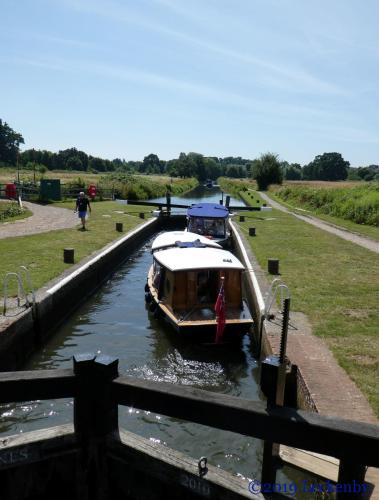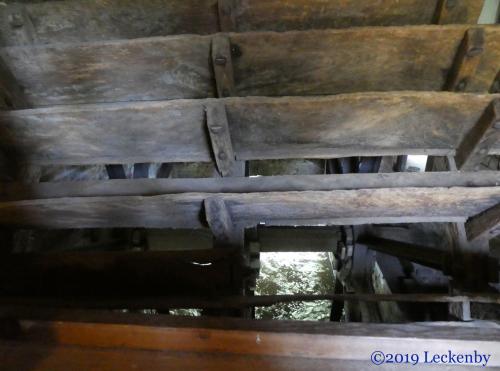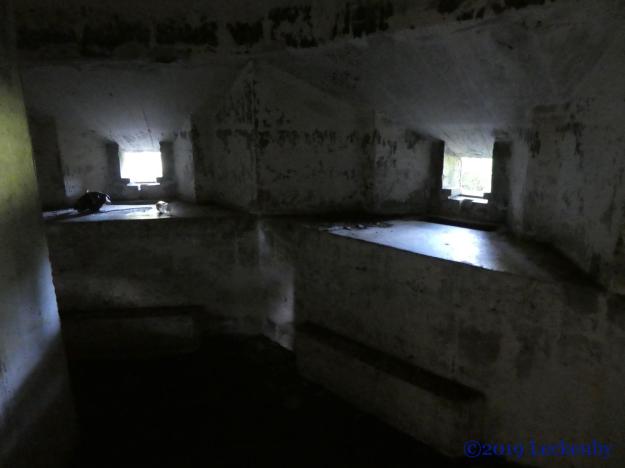Shore leave whilst they have their morning Ding Ding is good. I normally like it when that happens because if I come back inside the next time I go outside it has usually been changed. However today it just changed into a hotter version of the earlier outside. I stayed inside for much of the day.

Mick rang the Basingstoke Canal this morning. Sadly the navigation will be closing on Friday as their water levels are so low. So our trip there will have to be added to the ‘Next Time’ list. So once we reach Godalming we’ll gradually make our way back to the Thames a bit earlier than originally planned.

Taking advantage of the second mate being on board we applied suncream and headed out with wide brimmed hats. A walk along the towpath back to St Catherines Lock. Here two of the electric launches from Daphne Dap Dune Wharf were coming up in the three foot deep lock, it was taking forever!

Standing on the bridge we watched as a day boat came towards the lock to wait it’s turn to go down. In the photo above there is something wrong, we spotted it and tried for a while to get the crews attention. A day boat got the blame for leaving the bottom paddles up, yes they should have closed them, but you’d have thought the crew would have spotted them, especially on a length of river predominantly used by day boats with novice crew.

We crossed over and carried on our walk through the meadows back down the off side of the river. The launches were being moored up at a landing a short distance along where the path heads across the fields and a dried up bog up to The Street. I guessed that the passengers were all heading to the same place as us, Shalford Mill.

The tour guides at the Mill were busy preparing for the trip boats. There was a choice. 1, we could wait for an hour and join in with one of the two tours around the mill, waiting would involve watching around 24 people tucking into a picnic lunch whilst we stood around with our bottle of water. Or 2, we could have a shorter tour than normal on our own ahead of the masses. We opted for the second option.

Tilling Bourne River runs down the valley fed by springs along it’s length. The river had around 24 mills along it’s fifteen miles, all working hard. A centre of industry between the 17th and 20th centuries. Gun powder, paper making for bank notes, iron and wire working, tanning and flour milling made the place less then idyllic. Today watercress and trout are farmed along with a gin distillery.

Shalford Mill was re-built as two water powered mills in the 1750’s fed by the river and a large mill pond which would be left to fill over night for use the following day. The mill continued milling through the Corn Laws, Swing Riots and plenty more. By the 1850’s Shalford Mill could still only deal with one ton of wheat a day where as steam driven mills were pushing through 300 tons. The mill continued, changing hands and being leased until 1907.

Around 1911 the water wheel became dislodged and ended up resting against one of the mill walls, no longer able to turn. Here it rested and still rests today.

In 1927 the mill was put up for sale, it eventually caught the eyes of Bill Stickers and Sister Agatha in 1931. The owner offered it to the ladies so long as they could maintain it. By the following year the ladies had raised funds for an endowment and the Mill was gifted to the National Trust. The east mill was converted into a home whilst the rest was open to visitors. The tenancy of the east mill is still in the same family, with the original tenants daughter, now 93, still living there with her daughter.

We were shown through the mill, where the sacks of grain were hoisted to the top floor, emptied down to be ground, full sacks of milled flour hoisted back up for storage. How the granite stones were cut for milling, how the flour and bran were separated.

Steep staircases take you to the top of the building where the air was heating up nicely amongst the rafters. We were very glad we weren’t up there with another twelve people!

Our guide John did his best to shoo others away so that we’d get the best tour time would allow before he was due to show the boat trip round. He certainly knew his stuff, only stopping when the string that controlled the amount of grain entering the stones broke in his hand. Nothing hard to mend, just a length of sisal string that would be replaced as soon as we left.

Finally we were shown the room that Bill Stickers and her gang kept for visits. Ferguson’s Gang was made up of five core members, all women with pseudonyms. They formed in 1927, their aim was to raise awareness of the need to protect rural areas and they supported the National Trust. The Gang raised huge sums to protect and preserve important buildings and land that could otherwise have been destroyed. They were eccentric ladies who made ‘swag’ donations to the trust, one time causing a bomb scare at an AGM when a metal pineapple was presented with a £100 note inside. The public loved them. The gang’s den a snap shot of 1930’s life.


Despite being on a quick tour John gave us his undivided attention and knowledge for 45 minutes before having to mend the string. The mill is only open two days a week and for £17 you can enjoy a boat trip there and back with a picnic. We saved our money and headed to Snooty’s Groceries for supplies where we enjoyed the air conditioning.

Our walk back to Oleanna brought us over the very low bridge. A few squirts of WD40 have been applied to the screws holding Oleanna’s horns, should we need to remove them to get under.

The afternoon was spent watching people enjoying the river in the heat. Numerous people jumping in to swim.

I had a visit to the pill box a short distance behind us. Sat on an old railway embankment it has views over the river. I couldn’t see any invading force so the country is still safe.


0 locks, 0 miles, 2 boats neither going up nor down, 1 mill just in time, 5 or 6 famous and secret ladies, 1 wheel, three floors, 2 mugs, 4 ciabatta rolls, 9 slices salami, 1 tub coleslaw, 1 low bridge, 1 lotus, 1 Tilly Bourne, 8 swimmers, 1 pill box, 2 scooters, 33ish C, 27.5 C inside, 17 C minimum, 3 crew managing to stay coolish.

